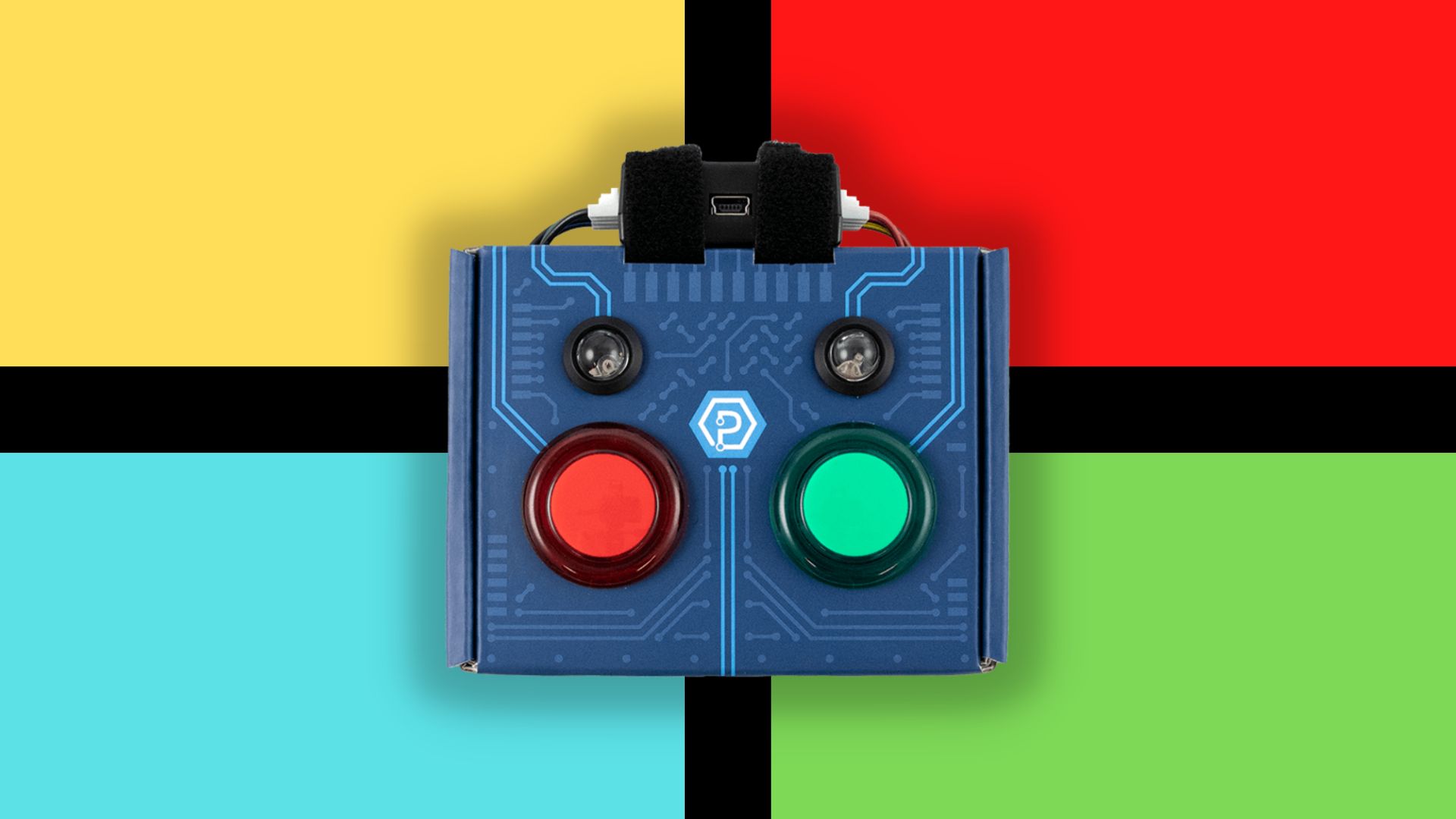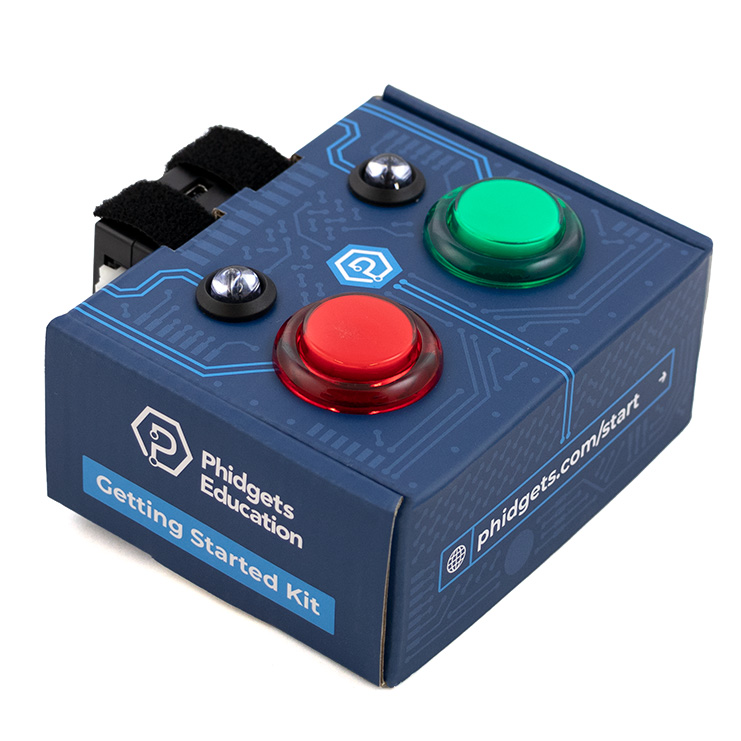Prerequisites
This project assumes you are familiar with the following
Setup
All you need for this project is the Getting Started Kit.
Write code (Java)
Copy the code below into a new Java project. If you need a reminder of how to do this, revisit the Getting Started Course.
Not your programming language? Set your preferences so we can display relevant code examples
//Add Phidgets Library.
import com.phidget22.*;
import java.util.ArrayList;
public class SimonSays {
//Track number of button events
public static int numEvents = 0;
public static void main(String[] args) throws Exception {
//Track user input and solutions
ArrayList<Integer> sequenceKey = new ArrayList<>();
ArrayList<Integer> userAnswer = new ArrayList<>();
//Determine starting # of colors
int numColors = 3;
//Determine if game should continue looping
boolean continueGame = true;
//Create
DigitalInput redButton = new DigitalInput();
DigitalOutput redLED = new DigitalOutput();
DigitalInput greenButton = new DigitalInput();
DigitalOutput greenLED = new DigitalOutput();
//Address
redButton.setHubPort(0);
redButton.setIsHubPortDevice(true);
redLED.setHubPort(1);
redLED.setIsHubPortDevice(true);
greenButton.setHubPort(5);
greenButton.setIsHubPortDevice(true);
greenLED.setHubPort(4);
greenLED.setIsHubPortDevice(true);
//Event for red button
redButton.addStateChangeListener(new DigitalInputStateChangeListener() {
public void onStateChange(DigitalInputStateChangeEvent e) {
try{
redLED.setState(e.getState());
if (e.getState()) {
userAnswer.add(0);
numEvents++;
}
} catch(PhidgetException ex){
System.out.println("Error: " + ex);
}
}
});
//Event for green button
greenButton.addStateChangeListener(new DigitalInputStateChangeListener() {
public void onStateChange(DigitalInputStateChangeEvent e) {
try{
greenLED.setState(e.getState());
if (e.getState()) {
userAnswer.add(1);
numEvents++;
}
}catch(PhidgetException ex){
System.out.println("Failure: " + ex);
}
}
});
//Open
redLED.open(1000);
greenLED.open(1000);
redButton.open(1000);
greenButton.open(1000);
System.out.println("Starting game, look at the LEDs.");
Thread.sleep(2000);
//Game loop
while (continueGame) {
//Generate answer key for this round
sequenceKey.clear();
for (int i = 0; i < numColors; i++) {
sequenceKey.add((int) (Math.random() * 2)); //randomly generate either 0 or 1
}
//Flash the answer key for user to memorize
for (int i = 0; i < sequenceKey.size(); i++) {
if (sequenceKey.get(i) == 0){ //0 is assigned to red
redLED.setState(true);
Thread.sleep(500);
redLED.setState(false);
}
else{ //1 is assigned to green
greenLED.setState(true);
Thread.sleep(500);
greenLED.setState(false);
}
Thread.sleep(500);
}
//reset before accepting answers
numEvents = 0;
userAnswer.clear();
System.out.println("Please enter your answer:");
//Wait for user input
while (numEvents < sequenceKey.size()){
Thread.sleep(150);
}
//Compare user answers to key
for (int i = 0; i < sequenceKey.size(); i++) {
if (userAnswer.get(i) != sequenceKey.get(i)) {
System.out.println("Game Over! You reached level: " + (numColors-3));
continueGame = false;
}
}
if (continueGame)
{
//Indicates the user got the sequence correct
System.out.println("Congrats! Starting next level...");
Thread.sleep(2000);
numColors++;
}
}
}
}
package simonsays;
//Add Phidgets Library.
import com.phidget22.*;
import java.util.ArrayList;
public class SimonSays {
//Track number of button events
public static int numEvents = 0;
public static void main(String[] args) throws Exception {
//Track user input and solutions
ArrayList<Integer> sequenceKey = new ArrayList<>();
ArrayList<Integer> userAnswer = new ArrayList<>();
//Determine starting # of colors
int numColors = 3;
//Determine if game should continue looping
boolean continueGame = true;
//Create
DigitalInput redButton = new DigitalInput();
DigitalOutput redLED = new DigitalOutput();
DigitalInput greenButton = new DigitalInput();
DigitalOutput greenLED = new DigitalOutput();
//Address
redButton.setHubPort(0);
redButton.setIsHubPortDevice(true);
redLED.setHubPort(1);
redLED.setIsHubPortDevice(true);
greenButton.setHubPort(5);
greenButton.setIsHubPortDevice(true);
greenLED.setHubPort(4);
greenLED.setIsHubPortDevice(true);
//Event for red button
redButton.addStateChangeListener(new DigitalInputStateChangeListener() {
public void onStateChange(DigitalInputStateChangeEvent e) {
try{
redLED.setState(e.getState());
if (e.getState()) {
userAnswer.add(0);
numEvents++;
}
} catch(PhidgetException ex){
System.out.println("Error: " + ex);
}
}
});
//Event for green button
greenButton.addStateChangeListener(new DigitalInputStateChangeListener() {
public void onStateChange(DigitalInputStateChangeEvent e) {
try{
greenLED.setState(e.getState());
if (e.getState()) {
userAnswer.add(1);
numEvents++;
}
}catch(PhidgetException ex){
System.out.println("Failure: " + ex);
}
}
});
//Open
redLED.open(1000);
greenLED.open(1000);
redButton.open(1000);
greenButton.open(1000);
System.out.println("Starting game, look at the LEDs.");
Thread.sleep(2000);
//Game loop
while (continueGame) {
//Generate answer key for this round
sequenceKey.clear();
for (int i = 0; i < numColors; i++) {
sequenceKey.add((int) (Math.random() * 2)); //randomly generate either 0 or 1
}
//Flash the answer key for user to memorize
for (int i = 0; i < sequenceKey.size(); i++) {
if (sequenceKey.get(i) == 0){ //0 is assigned to red
redLED.setState(true);
Thread.sleep(500);
redLED.setState(false);
}
else{ //1 is assigned to green
greenLED.setState(true);
Thread.sleep(500);
greenLED.setState(false);
}
Thread.sleep(500);
}
//reset before accepting answers
numEvents = 0;
userAnswer.clear();
System.out.println("Please enter your answer:");
//Wait for user input
while (numEvents < sequenceKey.size()){
Thread.sleep(150);
}
//Compare user answers to key
for (int i = 0; i < sequenceKey.size(); i++) {
if (userAnswer.get(i) != sequenceKey.get(i)) {
System.out.println("Game Over! You reached level: " + (numColors-3));
continueGame = false;
}
}
if (continueGame)
{
//Indicates the user got the sequence correct
System.out.println("Congrats! Starting next level...");
Thread.sleep(2000);
numColors++;
}
}
}
}
Code not available.
Write code (Python)
Copy the code below into a new Python project. If you need a reminder of how to do this, revisit the Getting Started Course.
Not your programming language? Set your preferences so we can display relevant code examples
#Add Phidgets Library
from Phidget22.Phidget import *
from Phidget22.Devices.DigitalInput import *
from Phidget22.Devices.DigitalOutput import *
#Required for sleep statement
import time
#Required for random number generator
import random
#Track number of button events
num_events = 0
#Track user input and solution
sequence_key = []
user_answer = []
#Determine starting # of colors
num_colors = 3
#Determine if game should continue looping
continue_game = True
#Event
def onRedButton_StateChange(self, state):
global num_events
redLED.setState(state)
if (state):
user_answer.append(0)
num_events += 1
#Event
def onGreenButton_StateChange(self, state):
global num_events
greenLED.setState(state)
if (state):
user_answer.append(1)
num_events += 1
#Create
redButton = DigitalInput()
redLED = DigitalOutput()
greenButton = DigitalInput()
greenLED = DigitalOutput()
#Address
redButton.setHubPort(0)
redButton.setIsHubPortDevice(True)
redLED.setHubPort(1)
redLED.setIsHubPortDevice(True)
greenButton.setHubPort(5)
greenButton.setIsHubPortDevice(True)
greenLED.setHubPort(4)
greenLED.setIsHubPortDevice(True)
#Subscribe to Events
redButton.setOnStateChangeHandler(onRedButton_StateChange)
greenButton.setOnStateChangeHandler(onGreenButton_StateChange)
#Open
redLED.openWaitForAttachment(1000)
greenLED.openWaitForAttachment(1000)
redButton.openWaitForAttachment(1000)
greenButton.openWaitForAttachment(1000)
print("Starting game, look at the LEDS.")
time.sleep(2)
#Game loop
while (continue_game):
#Generate answer key for this round
sequence_key.clear()
for i in range(num_colors):
sequence_key.append(int(random.random() * 2)) #randomly generate either 0 or 1
#Flash the answer key for user to memorize
for i in range(len(sequence_key)):
if sequence_key[i] == 0: #0 is assigned to red
redLED.setState(True)
time.sleep(0.5)
redLED.setState(False)
else: #1 is assigned to green
greenLED.setState(True)
time.sleep(0.5)
greenLED.setState(False)
time.sleep(0.5)
#Reset before accepting answers
num_events = 0
user_answer.clear()
print("Please enter your answer:")
#Wait for user input
while (num_events < len(sequence_key)):
time.sleep(0.1)
#Compare user answers to answer key
for i in range(len(sequence_key)):
if user_answer[i] != sequence_key[i]:
print("Game Over! You reached level: " + str(num_colors-3) +"\n")
continue_game = False
if (continue_game):
print("Congrats! Starting next level...")
time.sleep(2)
num_colors += 1 #Increase difficulty for next level
Write code (C#)
Copy the code below into a new C# project. If you need a reminder of how to do this, revisit the Getting Started Course.
Not your programming language? Set your preferences so we can display relevant code examples
//Add Phidgets Library
using Phidget22;
using System.Collections;
using System.Collections.Generic;
namespace SimonSays
{
class Program
{
//Track number of button events
static int numEvents = 0;
//Track user input and solutions
public static List<int> sequenceKey = new List<int>();
public static List<int> userAnswer = new List<int>();
//public static ArrayList sequenceKey = new ArrayList();
//public static ArrayList userAnswer = new ArrayList();
//Define here so they can be used in events
public static DigitalOutput redLED;
public static DigitalOutput greenLED;
//Event
private static void redButton_StateChange(object sender, Phidget22.Events.DigitalInputStateChangeEventArgs e)
{
redLED.State = e.State;
if (e.State)
{
userAnswer.Add(0);
numEvents++;
}
}
//Event
private static void greenButton_StateChange(object sender, Phidget22.Events.DigitalInputStateChangeEventArgs e)
{
greenLED.State = e.State;
if (e.State)
{
userAnswer.Add(1);
numEvents++;
}
}
static void Main(string[] args)
{
//Determine starting # of colors
var numColors = 3;
//Determine if game should continue looping
bool continueGame = true;
//Create
DigitalInput redButton = new DigitalInput();
DigitalInput greenButton = new DigitalInput();
redLED = new DigitalOutput();
greenLED = new DigitalOutput();
//Address
redButton.HubPort = 0;
redButton.IsHubPortDevice = true;
redLED.HubPort = 1;
redLED.IsHubPortDevice = true;
greenButton.HubPort = 5;
greenButton.IsHubPortDevice = true;
greenLED.HubPort = 4;
greenLED.IsHubPortDevice = true;
//Subscribe to events
redButton.StateChange += redButton_StateChange;
greenButton.StateChange += greenButton_StateChange;
//Open
redLED.Open(1000);
greenLED.Open(1000);
redButton.Open(1000);
greenButton.Open(1000);
//Creates random number generator
System.Random RNG = new System.Random();
System.Console.WriteLine("Starting game, look at the LEDS.");
System.Threading.Thread.Sleep(2000);
//Loop that keeps game going
while (continueGame)
{
//Generate answer key for this round
sequenceKey.Clear();
for (int i = 0; i < numColors; i++)
{
int randomNumber = RNG.Next(0, 2); //randomly generate either 0 or 1
sequenceKey.Add(randomNumber);
}
//Flash the answer key for user to memorize
for (int i = 0; i < sequenceKey.Count; i++)
{
if (sequenceKey[i] == 0) //0 is assigned to red
{
redLED.State = true;
System.Threading.Thread.Sleep(500);
redLED.State = false;
}
else //1 is assigned to green
{
greenLED.State = true;
System.Threading.Thread.Sleep(500);
greenLED.State = false;
}
System.Threading.Thread.Sleep(500);
}
//reset before accepting answers
numEvents = 0;
userAnswer.Clear();
System.Console.WriteLine("Please enter your answer:");
//Wait for user input
while (numEvents < sequenceKey.Count)
{
System.Threading.Thread.Sleep(150);
}
//Compare user answers to key
for (int i = 0; i < sequenceKey.Count; i++)
{
if (userAnswer[i] != sequenceKey[i])
{
System.Console.WriteLine("Game Over! You reached level : " + (numColors-3));
System.Console.ReadLine();
continueGame = false;
}
}
if (continueGame)
{
System.Console.WriteLine("Congrats! Starting next level...");
System.Threading.Thread.Sleep(2000);
numColors++;
}
}
}
}
}
Write code (Swift)
Copy the code below into a new Swift project. If you need a reminder of how to do this, revisit the Getting Started Course.
Not your programming language? Set your preferences so we can display relevant code examples
Code not available.
Run Your Program
After the initial LED sequence flashes, you will have to remember the sequence, and repeat it using the corresponding buttons!
Practice
- Play a sound effect every time an LED flashes. Hint: the RFID Sound Effects project shows how you can add audio to your code.
- Ask users for their name and log their scores to a file. Show a high score chart at the beginning and end of the game.
















